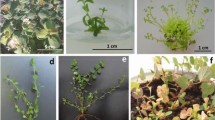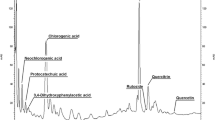Abstract
Hypericum polyanthemum Klotzsch ex Reichardt, an endemic species of Southern Brazil, was micropropagated on MS medium supplemented with 1.78 μM BAP. Shoot proliferation and rooting was achieved on hormone-free medium and plantlets survived acclimatization. The bioactive compounds: 6-isobutyryl-5,7-dimethoxy-2,2-dimethyl-benzopyran (HP1), 7-hydroxy-6-isobutyryl-5-methoxy-2,2-dimethyl-benzopyran (HP2) and 5-hydroxy-6-isobutyryl-7-methoxy-2,2-dimethyl-benzopyran (HP3) were quantified in the leaves, stems and roots of propagated and acclimatized plantlets and compared with the field-grown plants. The HPLC analysis revealed that the three benzopyrans are accumulated in the aerial parts and the concentration varied with the age of the plant whereas the roots were capable of accumulating only HP3. Greatest yield of HP1 (7.12 mg/g DW) was quantified in the leaves of the acclimatized plantlets, whereas the flowers of the plants from natural habitat displayed higher amounts of HP2 (11.04 mg/g DW) and HP3 (13.99 mg/g DW).


Similar content being viewed by others
Abbreviations
- BAP:
-
6-Benzylaminopurine
- HP1:
-
6-Isobutyryl-5,7-dimethoxy-2,2-dimethyl-benzopyran
- HP2:
-
7-Hydroxy-6-isobutyryl-5-methoxy-2,2-dimethyl-benzopyran
- HP3:
-
5-Hydroxy-6-isobutyryl-7-methoxy-2,2-dimethyl-benzopyran
- HPLC:
-
High performance liquid chromatography
- IAA:
-
Indole-3-acetic acid
- DW:
-
Dry weight
- MS:
-
Murashige and Skoog
- NAA:
-
α-Naphthalene-acetic acid
References
Abreu IN, Mazzafera P (2005) Effect of water and temperature stress on the content of active constituents of Hypericum brasiliense Choisy. Plant Physiol Biochem 43:241–248
Agostinis PA, Vantieghem A, Merlevede W, de Witte P (2002) Hypericin in cancer treatment: more light on the way. Int J Biochem Cell Biol 34:221–241
Briskin DP, Gawienowski MC (2001) Differential effects of light and nitrogen on production of hypericins and leaf glands in Hypericum perforatum. Plant Physiol Biochem 39:1075–1081
Cardoso MA, Oliveira DE (1996) Tissue culture of Hypericum brasiliense Choisy: shoot multiplication and callus induction. Plant Cell Tiss Org Cult 44:91–94
Cellárová E, Kimáková K, Brutovská R (1992) Multiple shoot formation and phenotypic changes of R0 regenerants in Hypericum perforatum L. Acta Biotechnol 12:445–452
Chatterjee SS, Nöldner M, Koch E, Erdelmeier E (1998) Antidepressant activity of Hypericum perforatum and hyperforin: the neglected possibility. Pharmacopsychiatry 31:7–15
Dall’Agnol R, Ferraz A, Bernardi AP, Albring D, Nor C, Sarmento L, Lamb L, Hass M, von Poser GL, Schapoval EES (2003) Antimicrobial activity of some Hypericum species. Phytomedicine 10:141–147
Daudt R, Poser GLV, Staats C, Neves G, Rates SMK (2000) Screening for the antidepressant activity of some species of Hypericum from South Brazil. Phytother Res 14:344–346
Diwu Z (1995) Novel therapeutic and diagonistic applications of hypocrellins and hypericins. Photochem Photobiol 61:529–539
Ferraz ABF, Bordignon S, Staats C, Schripsema J, von Poser GL (2001) Benzopyrans from Hypericum polyanthemun. Phytochemistry 57:1227–1230
Ferraz ABF, Grivicich I, von Poser GL, Faria DH, Kayser GB, Schwartsmann G, Henriques AT, da Rocha AB (2005a) Antitumor activity of three benzopyrans isolated from Hypericum polyanthemun. Fitoterapia 76:210–215
Ferraz ABF, Faria DH, Benneti MN, da Rocha AB, Schwartsmann G, Henriques AT, von Poser GL (2005b) Screening for antiproliferative activity of six southern Brazilian species of Hypericum. Phytomedicine 12:112–115
Gnerre C, von Poser GL, Ferraz AC, Viana A, Testa B, Rates SMK (2001) Monoamine oxidase inhibitory activity of some Hypericum species native to South Brazil. J Pharm Pharmacol 53:1273–1279
Jiménes CR (1980) Hipericaceaes. Flora Ilustrada Catarinense. Editora IOESC, Florianópolis, pp 3–32
Magii F, Ferretti G, Pocceshi N, Menghini L, Ricciutelli M (2004) Morphological, histochemical and phytochemical investigation of the genus Hypericum of the Central Italy. Fitoterapia 75:702–711
McCoy JA, Camper ND (2002) Development of a micropropagation protocol for St. John’s Wort (Hypericum perforatum L.). HortScience 37:978–980
Mentz LA, Lutzemberger LC, Schenkel EP (1997) Da flora medicinal do Rio Grande do Sul: notas sobre a obra literária de D’Ávila. Cad Farm 13:25–47
Moura M (1998) Conservation of Hypericum foliosum Aiton, na endemic Azorean species, by micropropagation. In Vitro Cell Dev Biol Plant 34:244–248
Murashige T, Skoog F (1962) A revised medium for rapid growth and bioassays with tobacco tissue cultures. Physiol Plant 15:473–497
Murch SJ, Rupasinghe HPV, Saxena PK (2002) An in vitro and hydroponic growing system for hypericin, pseudohypericin, and hyperforin production of St. John’s wort (Hypericum perforatum L. cv New Stem). Planta Med 68:1108–1112
Öztürk Y (1997) Testing the antidepressant effects of Hypericum species on animal models. Pharmacopsychiatry 40:125–128
Pasqua G, Avato P, Monacelli B, Santamaria AR, Argentieri MP (2003) Metabolites in cell suspension cultures, calli, and in vitro regenerated organs of Hypericum perforatum cv. Topas Plant Sci 165:977–982
Robson NKB. (1990) Studies in the genus Hypericum L. (Guttiferae) 8. Sections 29. Brathys (part 2) and 30. Trigynobrathys. Bull Br Mus 20:1–151
Singer AS, Wonnemann M, Muller W (1998) Hyperforin, a major antidepressant constituent of St. John’s Wort, inhibits serotonin uptake by elevating free intracellular Na+1. J Pharmacol Exp Ther 290:1363–1368
Sokal RR, Rohlf FJ (1981) Biometry. Freeman, San Francisco, p 859
Southwell IA, Bourke CA (2001) Seasonal variation in hypericin content of Hypericum perforatum L. (St. John’s wort). Phytochemistry 56:437–441
Takel’ova D, Repcak M, Zemkova E, Toth J (2000) Quantitative changes in dianthrones, hyperforin and flavonoids in the flower ontogenesis of Hypericum perforatum. Planta Med 66:778–780
Tamas LA (1987) Hormonal regulation of apical dominance. In: Davies PJ (ed) Plant hormones and their role in plant growth and development. Martinus Nijhoff, Dordrecht, pp 393–410
Viana AF, Heckler AP, Fenner R, Rates SMK (2003) Analgesic activity of Hypericum caprifoliatum and Hypericum polyanthemum (Guttiferae). Braz J Med Biol Res 36:631–634
Vyas AV, Mulchandani NB (1980) Biosynthesis of precocenes –I and –II, anti-juvenile hormones. Phytochemistry 19:2597–2598
Acknowledgments
This study was supported by CNPq, FAPERGS and Propesq-UFRGS. The authors thank CBIM/UFRGS for the HPLC facilities.
Author information
Authors and Affiliations
Corresponding author
Additional information
Communicated by S. Lewak.
Rights and permissions
About this article
Cite this article
Bernardi, A.P.M., Maurmann, N., Rech, S.B. et al. Benzopyrans in Hypericum polyanthemum Klotzsch ex Reichardt cultured in vitro. Acta Physiol Plant 29, 165–170 (2007). https://doi.org/10.1007/s11738-006-0021-2
Received:
Accepted:
Published:
Issue Date:
DOI: https://doi.org/10.1007/s11738-006-0021-2




